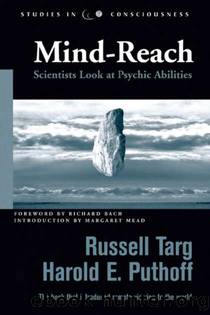Mind-Reach by Russell Targ

Author:Russell Targ
Language: eng
Format: epub
ISBN: 9781612830179
Publisher: Hampton Roads Publishing
Remote Viewing of a Flashing Light
On the basis of such results indicating that paranormal functioning is intimately connected with brain functioning, we thought it should be possible to obtain direct evidence of remote perception by measurement of brain waves.
Well-known researchers in the neurosciences, Dr. Joseph Kamiya, Dr. Karl Pribram, Dr. W. Grey Walter, and others, brought together to discuss physiological methods to detect ESP functioning, have suggested that brain wave EEG (electroencephalogram) responses may be sensitive indicators of parasensory detection of remote stimuli.4 We therefore undertook such a study.
Related experimentation of this type had been carried out by Douglas Dean at the Newark College of Engineering. In his search for physiological indicators of information transfer, he used a Plethysmograph to measure changes in the blood volume in a finger during telepathy experiments. (The plethysmograph is a sensitive indicator of autonomic nervous system functioning.) A sender looked at randomly selected target cards consisting of names known to the subject, together with names unknown to him (selected at random from a telephone book). The names of the known people were contributed by the subject and were to be of emotional significance to himâmother, wife, sweetheart, stockbroker, etc. Dean found significant changes in the chart recording of finger blood volume when the remote sender was looking at those names known to the subject as compared with when he was looking at those names randomly chosen.5
Three other experiments using the physiological approach have now been published. The first work by Tart,6 a later work by Lloyd,7 and most recently the work by the authors in collaboration with SRI neurophysiologists Dr. Charles Rebert and Dr. Ann Turner,8 all follow a similar pattern. Basically, a subject is closeted in an electrically shielded room while his EEG is recorded. Meanwhile, in another laboratory, a second person is stimulated according to a random schedule. The time of that stimulus is marked on magnetic tape, along with the recording of the subject's EEG. (The subject does not know, of course, when the remote stimulus periods are.)
In previous work, others had attempted without success to detect changes in a subject's EEG in response to a single flash from a stroboscopic. lamp being observed by another subject.9 In a discussion of that experiment, Kamiya had suggested that because of the unknown characteristics of the information channel with regard to the amount of time required to receive a signal, it might be more appropriate to use a train of light bursts to increase the probability of detecting information transfer.10 Therefore, in our study, we chose to use a stroboscopic flash train of ten-second duration as the target in a remote viewing experiment.
In the design of the study, we assumed that the remote stimulus would result in responses similar to those obtained under conditions of direct stimulation. For example, when an individual is stimulated with a low-frequency (less than twenty cycles per second) flashing light, the EEG typically shows a decrease in the strength of the resting alpha brain wave pattern and a driving of the brain waves at the frequency of the flashes.
Download
This site does not store any files on its server. We only index and link to content provided by other sites. Please contact the content providers to delete copyright contents if any and email us, we'll remove relevant links or contents immediately.
| ESP | Near-Death Experiences |
| Out-of-Body Experiences |
Animal Frequency by Melissa Alvarez(3760)
Sigil Witchery by Laura Tempest Zakroff(3657)
Real Magic by Dean Radin PhD(3574)
Fingerprints of the Gods by Graham Hancock(3223)
The Rosicrucians by Christopher McIntosh(3057)
Aleister Crowley: The Biography by Tobias Churton(3026)
Journeys Out of the Body by Robert Monroe(2997)
Alchemy and Alchemists by C. J. S. Thompson(2917)
Mysteries by Colin Wilson(2889)
Hitler's Monsters by Eric Kurlander(2737)
John Dee and the Empire of Angels by Jason Louv(2717)
Wicca: a guide for the solitary practitioner by Scott Cunningham(2711)
The Hatha Yoga Pradipika (Translated) by Svatmarama(2498)
Infinite Energy Technologies by Finley Eversole(2494)
Dark Star Rising by Gary Lachman(2426)
The Book of Lies by Aleister Crowley(2388)
Aliens by Jim Al-Khalili(2387)
To Light a Sacred Flame by Silver RavenWolf(2356)
Hitler's Flying Saucers: A Guide to German Flying Discs of the Second World War by Stevens Henry(2301)
